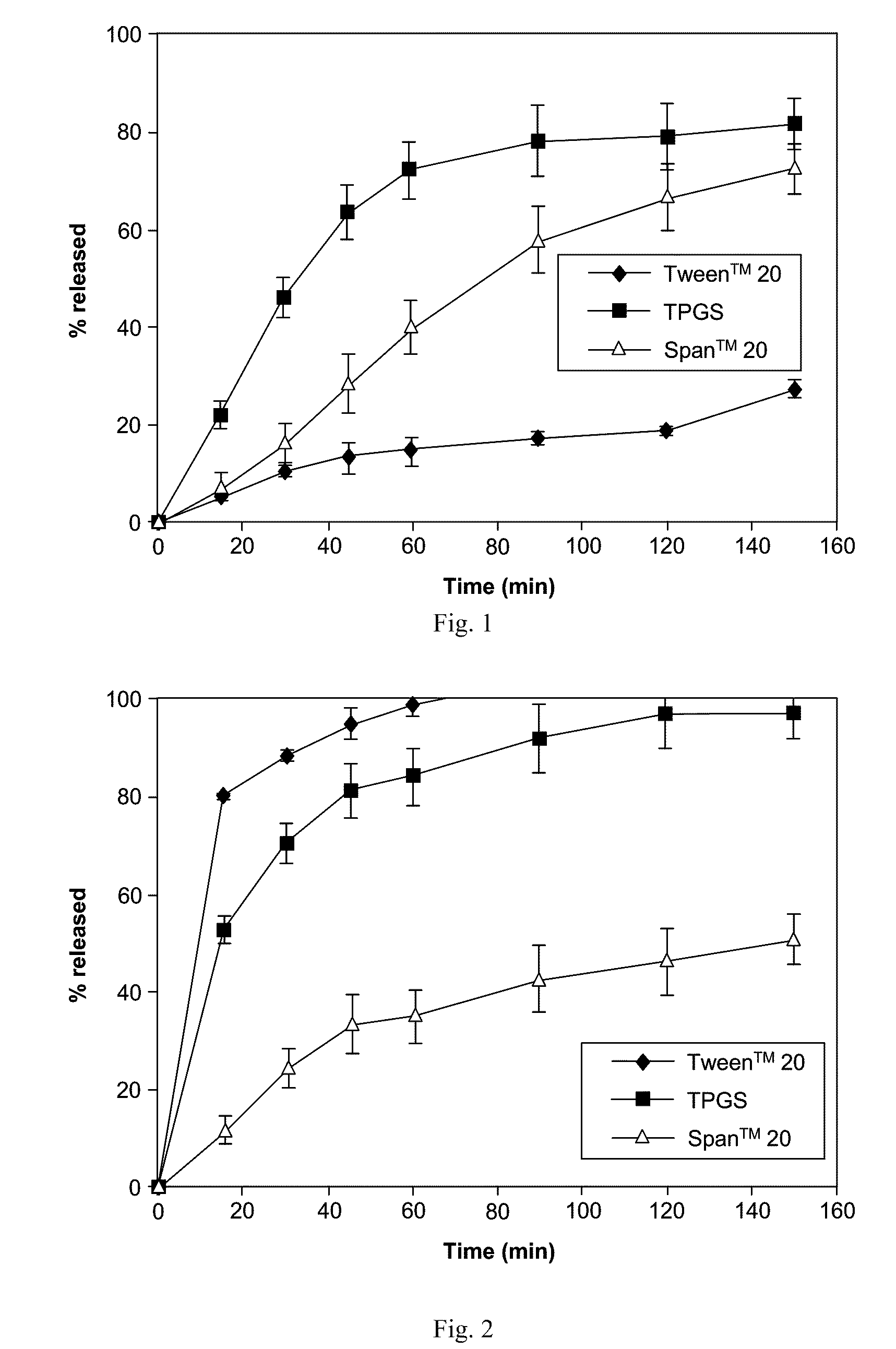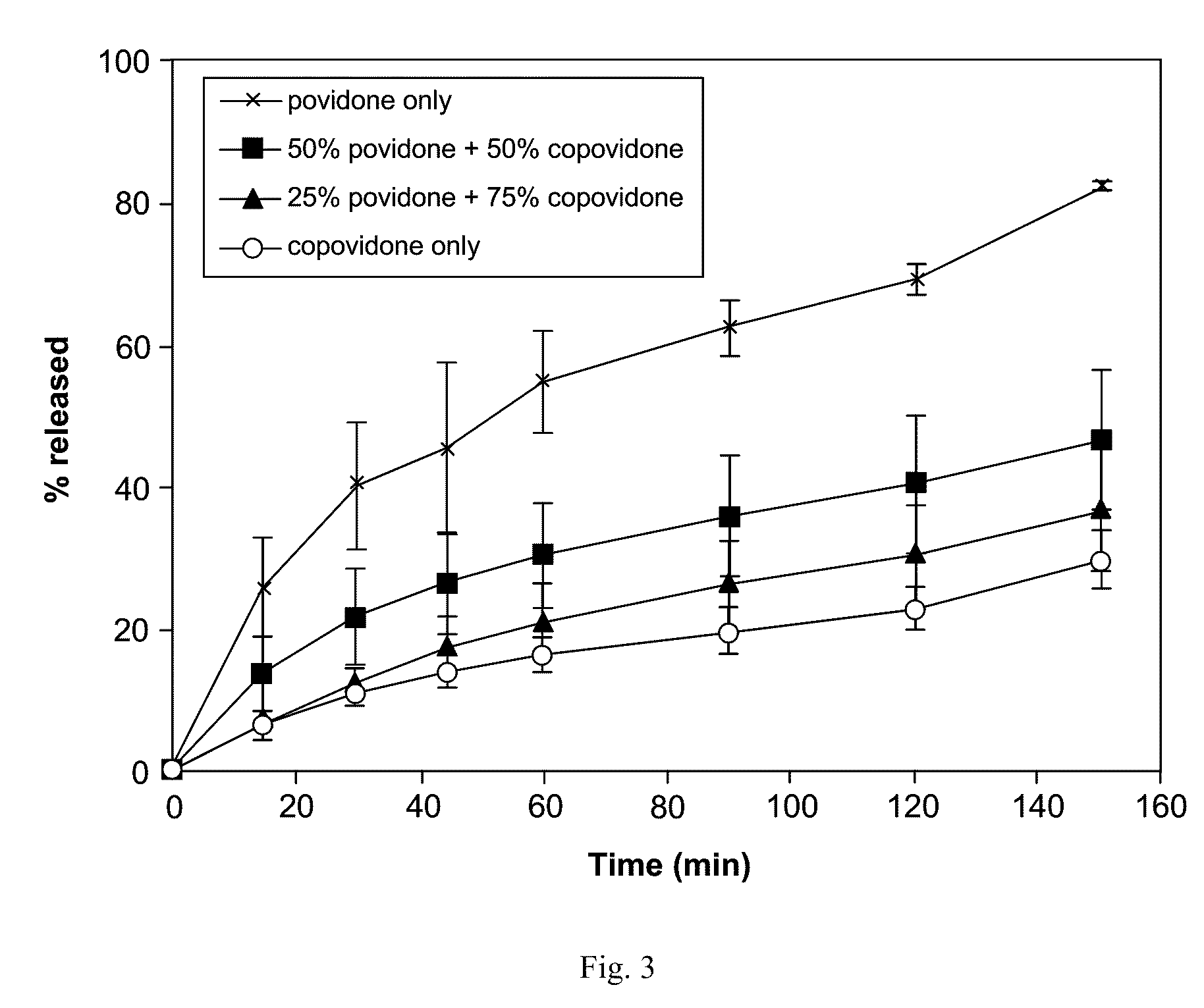Solid dispersions containing an apoptosis-promoting agent
a technology of apoptosis-promoting agents and solid dispersions, which is applied in the direction of drug compositions, muscular disorders, sexual disorders, etc., can solve the problems of not being able to achieve daily parenteral administration in clinical settings, tumors typically recur and eventually become refractory, and not being able to achieve clinically practicable daily parenteral administration, and enhancing cytotoxic effects, the effect of increasing stability
- Summary
- Abstract
- Description
- Claims
- Application Information
AI Technical Summary
Benefits of technology
Problems solved by technology
Method used
Image
Examples
example 1
Preparation of Solid Dispersions of ABT-263 bis-HCl
[0190]ABT-263 bis-HCl crystalline salt was mixed with a surfactant and a water-soluble polymer in the following weight ratios:
[0191]10.8% ABT-263 salt (10% free base equivalent); 10% surfactant; 79.2% polymer
[0192]21.5% ABT-263 salt (20% free base equivalent); 10% surfactant; 68.5% polymer
[0193]32.3% ABT-263 salt (30% free base equivalent); 10% surfactant; 57.7% polymer
[0194]43% ABT-263 salt (40% free base equivalent); 10% surfactant; 47% polymer
[0195]The surfactant in different series was TPGS, Span™ 20 or Tween™ 20. The polymer in different series was copovidone (Kollidon™ VA 64), povidone K-30 or HPMC-AS.
[0196]The mixture of ingredients in each case was dissolved in methanol. The methanol was removed at 65° C. in vacuo using a Genevac™ system, and the resulting solid dispersion was allowed to cool to ambient temperature.
[0197]The solid dispersion in each case was sieved through a 40-mesh screen to provide a powder of reduced part...
example 2
Preparation of Solid Dispersions of ABT-263 Free Base
[0200]ABT-263 bis-HCl crystalline salt was dissolved in acetone, and NaOH was added to convert the ABT-263 bis-HCl to free base. The NaCl by-product precipitated and was removed by filtration.
[0201]To the resulting ABT-263 free base solution in acetone were added a surfactant and a water-soluble polymer in the following weight ratios:
[0202]10% ABT-263 free base; 10% surfactant; 80% polymer
[0203]20% ABT-263 free base; 10% surfactant; 70% polymer
[0204]30% ABT-263 free base; 10% surfactant; 60% polymer
[0205]40% ABT-263 free base; 10% surfactant; 50% polymer
[0206]The surfactant in different series was TPGS, Span™ 20 or Tween™ 20. The polymer in different series was copovidone (Kollidon™ VA 64) or HPMC-AS.
[0207]The acetone was removed at 65° C. in vacuo using a Genevac™ system, and the resulting solid dispersion was allowed to cool to ambient temperature.
[0208]The solid dispersion in each case was sieved through a 40-mesh screen to pro...
example 3
Dissolution Profiles of Solid Dispersions
[0211]Representative dissolution (drug release) profiles in a pH 6.5 buffered medium containing 7.6 mM Tween™ 80 are shown in FIG. 1 (ABT-263 bis-HCl) and FIG. 2 (ABT-263 free base).
[0212]As shown in FIG. 1, at a 20% drug-loading level, the ABT-263 bis-HCl solid dispersions with 68.5% copovidone and 10% TPGS showed a moderate rate of drug release that plateaued at about 80% release. Release from similar dispersions having Span™ 20 or, especially, Tween™ 20 as the surfactant was much slower.
[0213]By contrast, as shown in FIG. 2, at the same 20% drug-loading level, the ABT-263 free base solid dispersions with 70% copovidone and 10% of either Tween™ 20 or TPGS showed rapid dug release. Only the Span™ 20 surfactant resulted in much slower release in the case of the free base dispersion.
[0214]Release rate was drug-loading-dependent in both ABT-263 bis-HCl and free base dispersion formulations, the 20% dispersions showing faster release than the 30...
PUM
| Property | Measurement | Unit |
|---|---|---|
| Fraction | aaaaa | aaaaa |
| Fraction | aaaaa | aaaaa |
| Percent by mass | aaaaa | aaaaa |
Abstract
Description
Claims
Application Information
 Login to View More
Login to View More - R&D
- Intellectual Property
- Life Sciences
- Materials
- Tech Scout
- Unparalleled Data Quality
- Higher Quality Content
- 60% Fewer Hallucinations
Browse by: Latest US Patents, China's latest patents, Technical Efficacy Thesaurus, Application Domain, Technology Topic, Popular Technical Reports.
© 2025 PatSnap. All rights reserved.Legal|Privacy policy|Modern Slavery Act Transparency Statement|Sitemap|About US| Contact US: help@patsnap.com



